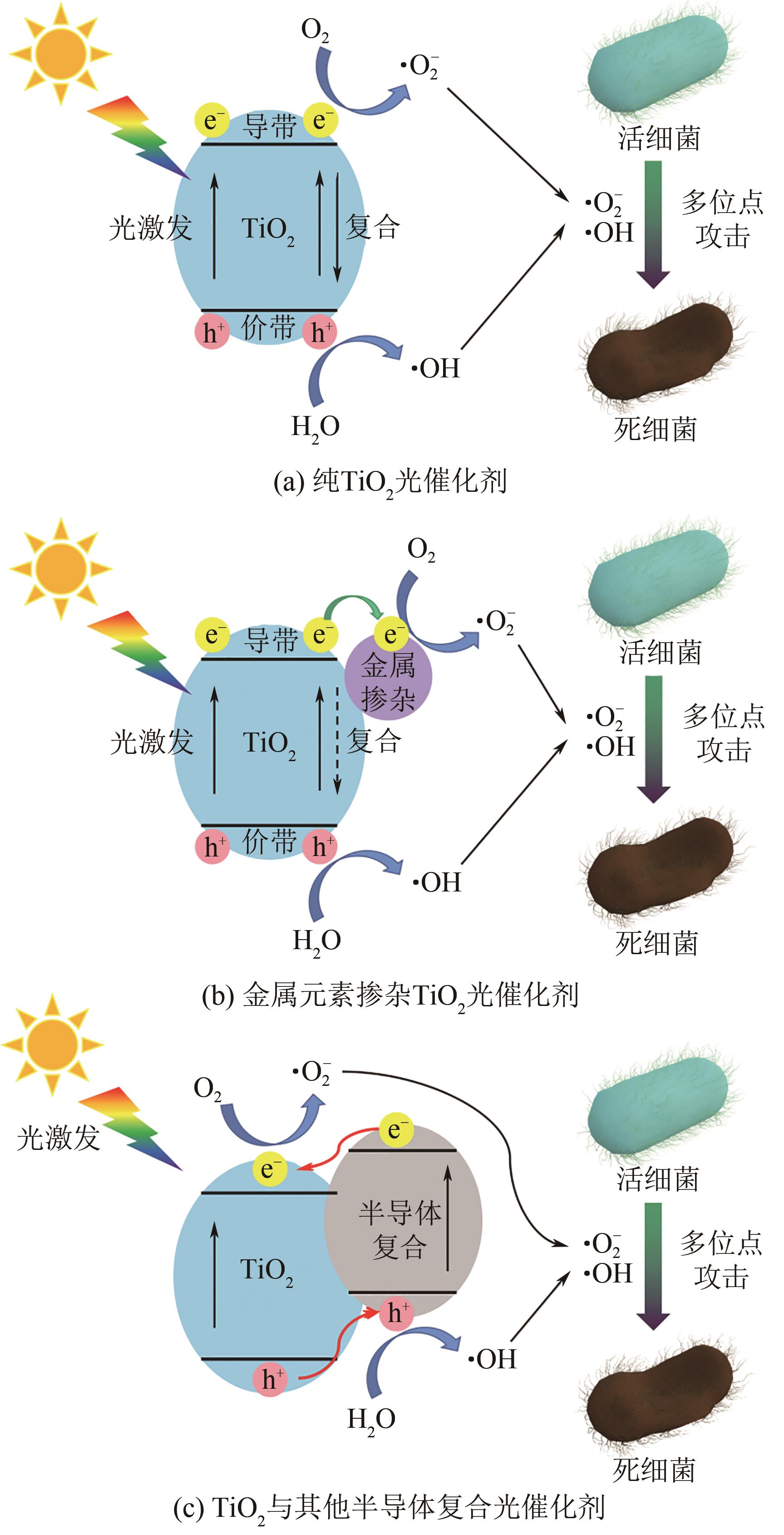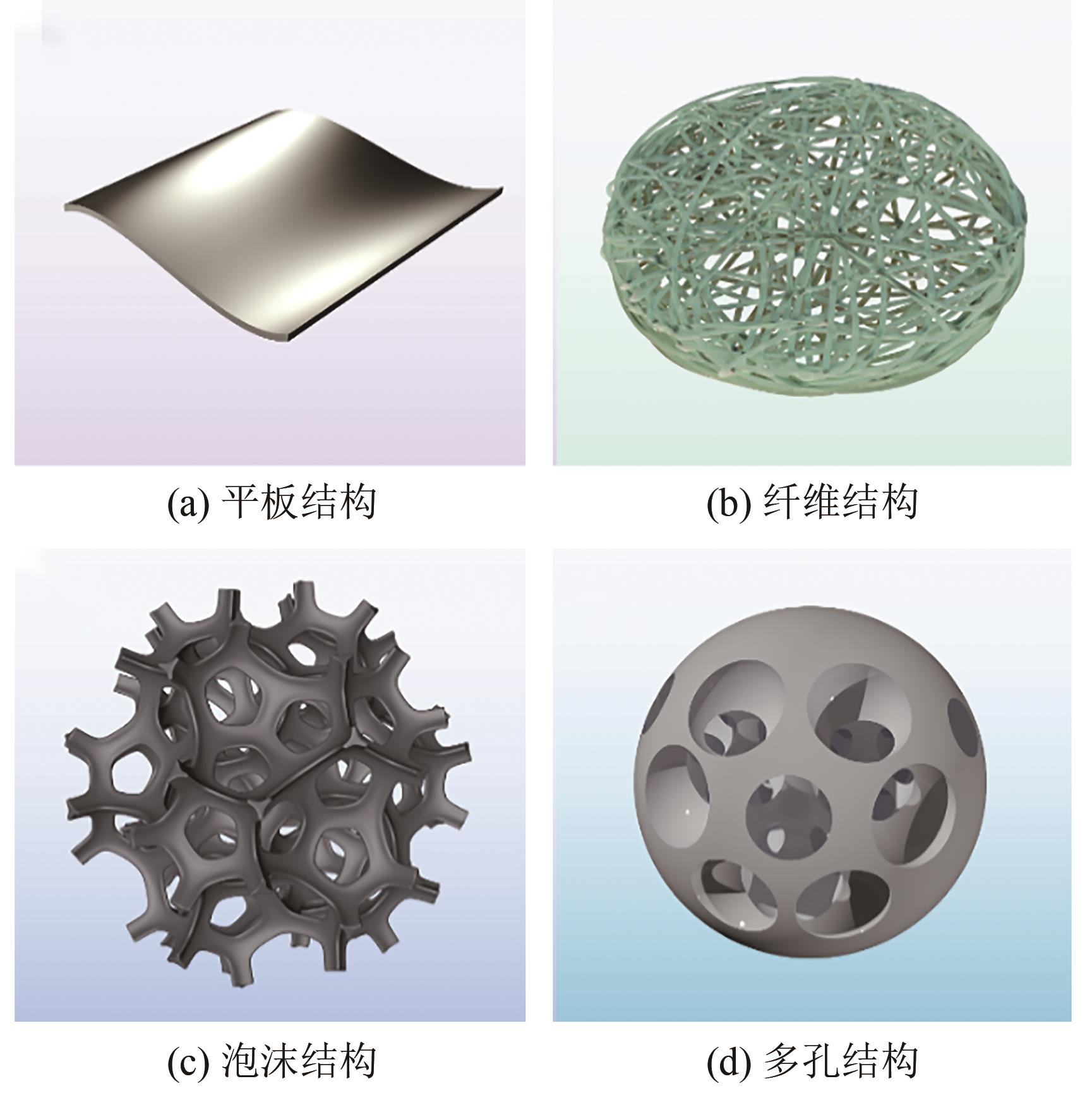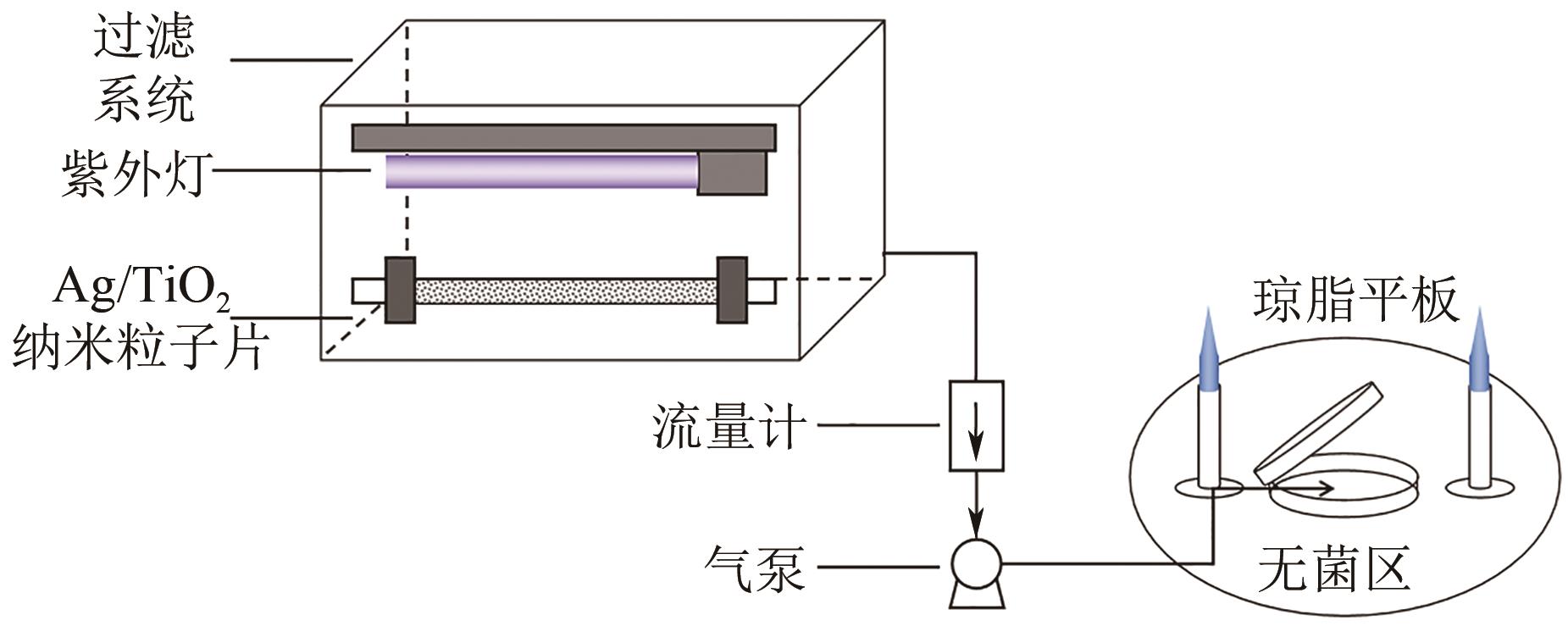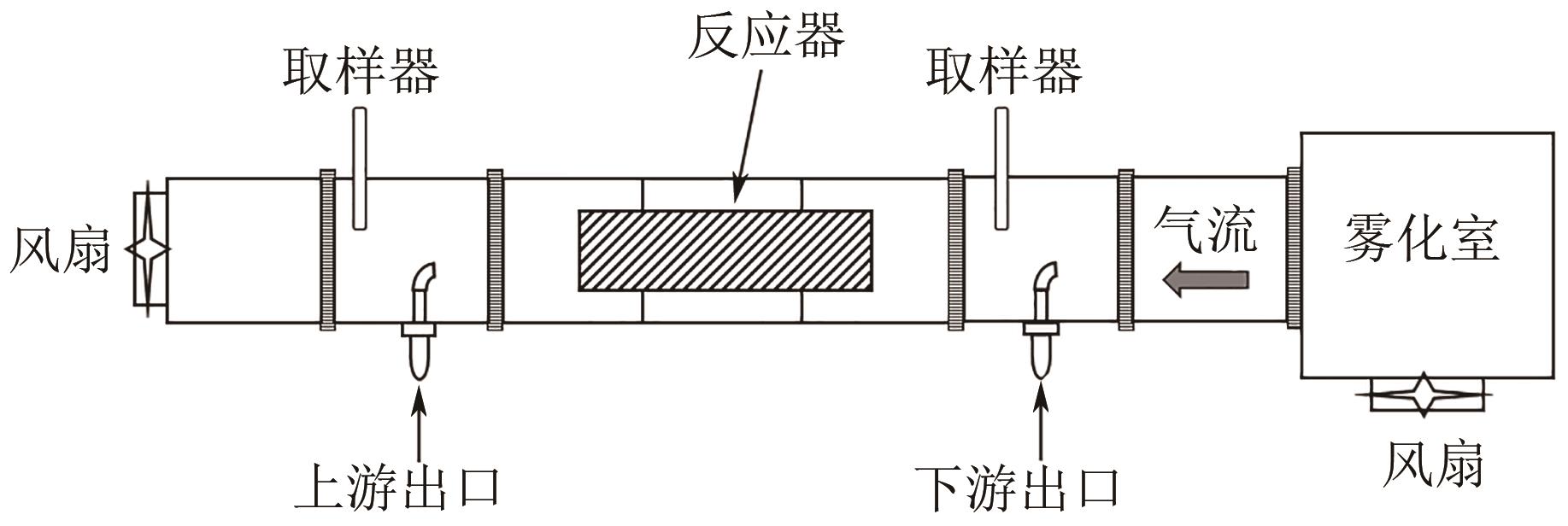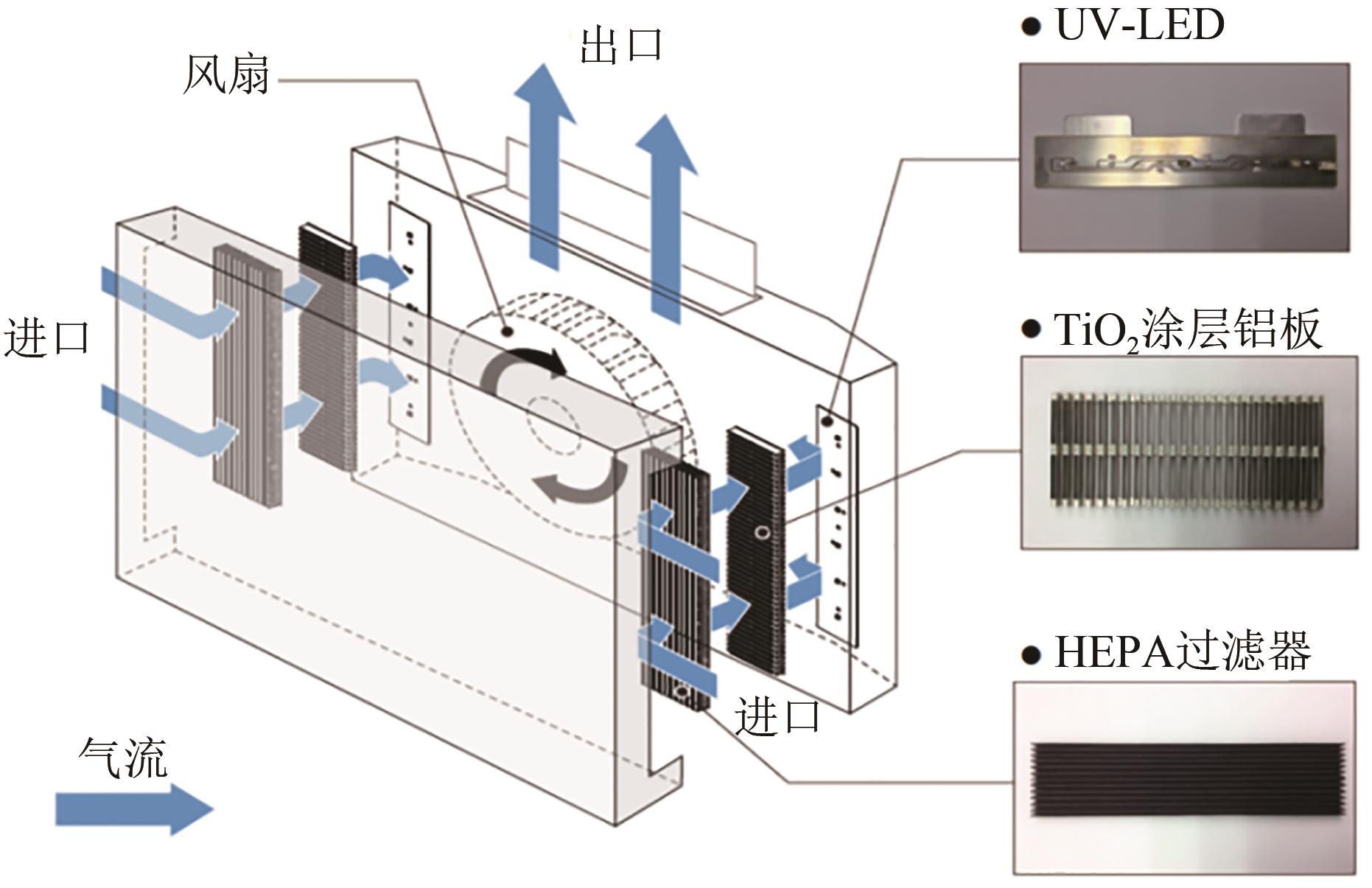化工进展 ›› 2023, Vol. 42 ›› Issue (2): 957-968.DOI: 10.16085/j.issn.1000-6613.2022-0628
光催化系统灭活微生物气溶胶的研究进展
程荣1( ), 邓子祺1, 夏锦程1, 李江2, 石磊1, 郑祥1(
), 邓子祺1, 夏锦程1, 李江2, 石磊1, 郑祥1( )
)
- 1.中国人民大学环境学院,北京 100872
2.中国蓝星(集团)股份有限公司,北京 100029
-
收稿日期:2022-04-12修回日期:2022-07-15出版日期:2023-02-25发布日期:2023-03-13 -
通讯作者:郑祥 -
作者简介:程荣(1981—),女,副教授,研究方向为环境公共卫生与环境功能材料。E-mail:chengrong@ruc.edu.cn。 -
基金资助:国家自然科学基金(52070192)
Research progress on photocatalysis systems for inactivation of microbial aerosol
CHENG Rong1( ), DENG Ziqi1, XIA Jincheng1, LI Jiang2, SHI Lei1, ZHENG Xiang1(
), DENG Ziqi1, XIA Jincheng1, LI Jiang2, SHI Lei1, ZHENG Xiang1( )
)
- 1.School of Environment and Natural Resources, Renmin University of China, Beijing 100872, China
2.China National Bluestar (Group) Co. , Ltd. , Beijing 100029, China
-
Received:2022-04-12Revised:2022-07-15Online:2023-02-25Published:2023-03-13 -
Contact:ZHENG Xiang
摘要:
在当前新型冠状病毒(SARS-CoV-2)引发的肺炎(COVID-19)疫情背景下,微生物气溶胶的控制与去除再次引起学界的重视,而常规的过滤、化学药剂、紫外等空气净化方式存在各自的缺陷与不足。光催化法具有高效、广谱、绿色、无残留、可动态持续消毒的优点,具有广阔的应用前景。本文从光催化剂的种类、光催化剂的负载、光源以及反应器的结构与运行等方面对光催化系统灭活微生物气溶胶的相关研究进行了总结与分析。文中指出:绝大多数研究选择TiO2或其衍生材料作为光催化剂,而更多新型、高效的光催化剂应当得到应用;多孔、多通道以及大表面积的催化剂载体能够有效提升光催化系统的效率;在光源的选择上仍然较多依赖于紫外光,可见光的应用有待更多的研究;从优化反应器结构入手改进光催化系统的研究较少,最常用的是环形反应器;已有研究者开发出光催化空气净化器,或将光催化系统与室内风管系统相结合。文章提出,未来光催化系统将会成为室内微生物气溶胶控制的重要手段。
中图分类号:
引用本文
程荣, 邓子祺, 夏锦程, 李江, 石磊, 郑祥. 光催化系统灭活微生物气溶胶的研究进展[J]. 化工进展, 2023, 42(2): 957-968.
CHENG Rong, DENG Ziqi, XIA Jincheng, LI Jiang, SHI Lei, ZHENG Xiang. Research progress on photocatalysis systems for inactivation of microbial aerosol[J]. Chemical Industry and Engineering Progress, 2023, 42(2): 957-968.
| 光催化剂种类 | 负载方法 | 载体 | 微生物种类 | 最高去除率/% | 参考文献 |
|---|---|---|---|---|---|
| TiO2 | 浸涂法 | 玻璃环 | 枯草芽孢杆菌 | 100 | [ |
| 反应器内壁 | 嗜肺军团菌 | 94 | [ | ||
| 高效空气过滤器 (HEPA)滤芯 | 大肠杆菌 | 100 | [ | ||
| 多种细菌、真菌 | 77 | [ | |||
| 表皮菌、枯草杆菌、尼日尔菌和青霉菌 | 98 | [ | |||
| 聚醚砜膜盘式过滤器 | 大肠杆菌、枯草芽孢杆菌、微杆菌 | 100 | [ | ||
| 硼硅酸盐板 | 多种细菌、真菌 | 98 | [ | ||
| 玻璃纤维过滤器 | 大肠杆菌K-12 | 100 | [ | ||
| β-SiC泡沫 | T2噬菌体 | 99.9 | [ | ||
| 多孔陶瓷板 | H1N1流感病毒 | 100 | [ | ||
| 铝板 | H1N1流感病毒 | 99.999 | [ | ||
| 陶瓷泡沫 | 大肠杆菌等5种细菌 | 99.9 | [ | ||
| 溶胶-凝胶法 | 玻璃纤维 | 大肠杆菌 | 97.7 | [ | |
| 化学接枝法 | 聚氨酯泡沫 | 嗜肺军团菌 | 90 | [ | |
| TiO2、ZnO | 浸涂法 | 乙酸纤维素蜂窝结构 | 多种细菌、真菌 | 98 | [ |
| 多孔玻璃珠 | 细菌、真菌 | 78 | [ | ||
| 溶胶-凝胶法 | 珍珠岩、多孔玻璃珠 | 细菌、真菌 | 77 | [ | |
| 珍珠岩 | 细菌、真菌 | 70 | [ | ||
| Cu/TiO2 | 溶胶-凝胶法 | 玻璃纤维 | 大肠杆菌 | 87.80 | [ |
| 无纺布 | 人类诺如病毒 | 99.87 | [ | ||
| 化学接枝法 | 聚氨酯泡沫 | 酵母菌 | — | [ | |
| Ag/TiO2 | 浸涂法 | 织物过滤器 | 细菌、真菌、病毒 | 100 | [ |
| 铝板、聚酯纤维 | 蜡样芽孢杆菌孢子 | 97.89 | [ | ||
| Cu/TiO2、Ag/TiO2 | 溶胶-凝胶法 | 玻璃纤维 | 大肠杆菌和金黄色葡萄球菌 | 94.46 | [ |
| TiO2/Cu2+、Ag@TiO2/Cu2+ | 浸涂法 | 珍珠岩 | 大肠杆菌、金黄色葡萄球菌 | 100 | [ |
| Pd/TiO2 | 静电自组装法、 溶胶-凝胶法 | 钛板 | MS2噬菌体 | 100 | [ |
| TiO2、Pt/TiO2 | 浸涂法 | 玻璃板 | 多种细菌、病毒 | 99.8 | [ |
| Ag/TiO2、Ag/ZnO | 喷涂法 | 反应灯内表面 | 环境空气细菌 | 96.48 | [ |
| ZIF-8 | 热压法 | 无纺布 | 大肠杆菌 | 99.99 | [ |
| TiO2/MXene | 浸涂法 | 聚氨酯泡沫 | 大肠杆菌 | 99.96 | [ |
表1 光催化气相消毒系统中光催化剂的种类与负载方式
| 光催化剂种类 | 负载方法 | 载体 | 微生物种类 | 最高去除率/% | 参考文献 |
|---|---|---|---|---|---|
| TiO2 | 浸涂法 | 玻璃环 | 枯草芽孢杆菌 | 100 | [ |
| 反应器内壁 | 嗜肺军团菌 | 94 | [ | ||
| 高效空气过滤器 (HEPA)滤芯 | 大肠杆菌 | 100 | [ | ||
| 多种细菌、真菌 | 77 | [ | |||
| 表皮菌、枯草杆菌、尼日尔菌和青霉菌 | 98 | [ | |||
| 聚醚砜膜盘式过滤器 | 大肠杆菌、枯草芽孢杆菌、微杆菌 | 100 | [ | ||
| 硼硅酸盐板 | 多种细菌、真菌 | 98 | [ | ||
| 玻璃纤维过滤器 | 大肠杆菌K-12 | 100 | [ | ||
| β-SiC泡沫 | T2噬菌体 | 99.9 | [ | ||
| 多孔陶瓷板 | H1N1流感病毒 | 100 | [ | ||
| 铝板 | H1N1流感病毒 | 99.999 | [ | ||
| 陶瓷泡沫 | 大肠杆菌等5种细菌 | 99.9 | [ | ||
| 溶胶-凝胶法 | 玻璃纤维 | 大肠杆菌 | 97.7 | [ | |
| 化学接枝法 | 聚氨酯泡沫 | 嗜肺军团菌 | 90 | [ | |
| TiO2、ZnO | 浸涂法 | 乙酸纤维素蜂窝结构 | 多种细菌、真菌 | 98 | [ |
| 多孔玻璃珠 | 细菌、真菌 | 78 | [ | ||
| 溶胶-凝胶法 | 珍珠岩、多孔玻璃珠 | 细菌、真菌 | 77 | [ | |
| 珍珠岩 | 细菌、真菌 | 70 | [ | ||
| Cu/TiO2 | 溶胶-凝胶法 | 玻璃纤维 | 大肠杆菌 | 87.80 | [ |
| 无纺布 | 人类诺如病毒 | 99.87 | [ | ||
| 化学接枝法 | 聚氨酯泡沫 | 酵母菌 | — | [ | |
| Ag/TiO2 | 浸涂法 | 织物过滤器 | 细菌、真菌、病毒 | 100 | [ |
| 铝板、聚酯纤维 | 蜡样芽孢杆菌孢子 | 97.89 | [ | ||
| Cu/TiO2、Ag/TiO2 | 溶胶-凝胶法 | 玻璃纤维 | 大肠杆菌和金黄色葡萄球菌 | 94.46 | [ |
| TiO2/Cu2+、Ag@TiO2/Cu2+ | 浸涂法 | 珍珠岩 | 大肠杆菌、金黄色葡萄球菌 | 100 | [ |
| Pd/TiO2 | 静电自组装法、 溶胶-凝胶法 | 钛板 | MS2噬菌体 | 100 | [ |
| TiO2、Pt/TiO2 | 浸涂法 | 玻璃板 | 多种细菌、病毒 | 99.8 | [ |
| Ag/TiO2、Ag/ZnO | 喷涂法 | 反应灯内表面 | 环境空气细菌 | 96.48 | [ |
| ZIF-8 | 热压法 | 无纺布 | 大肠杆菌 | 99.99 | [ |
| TiO2/MXene | 浸涂法 | 聚氨酯泡沫 | 大肠杆菌 | 99.96 | [ |
| 光源种类 | 光源额定功率 | 光照强度/mW·cm-2 | 微生物种类 | 最高去除率/% | 参考文献 |
|---|---|---|---|---|---|
| UVA | 6W×19个 | 内侧3.43;外侧1.89 | 枯草芽孢杆菌 | 100 | [ |
| 8W×2个 | 1.82~6.28 | 大肠杆菌、枯草芽孢杆菌、微杆菌 | 100 | [ | |
| 14W×6个 | 10 | 细菌、真菌、病毒 | 100 | [ | |
| 14W×43个 | 5 | 蜡样芽孢杆菌孢子 | 97.89 | [ | |
| 36W×5个 | 4.85±0.09 | 多种细菌、真菌 | 77 | [ | |
| 8W×2个 | 0.5~3.4 | 大肠杆菌K-12 | 100 | [ | |
| — | 1 | H1N1流感病毒 | 100 | [ | |
| — | 0.25 | 大肠杆菌等5种细菌 | 99.9 | [ | |
| UVC | — | 1.8 | 金黄色葡萄球菌 | 99.98 | [ |
| 18W、35W | 0.06~0.105 | 多种致病细菌、病毒 | 99.99 | [ | |
| 11W×2个 | 12.8 | 粪肠球菌、法氏囊病病毒 | 99.7 | [ | |
| UVC | 15W×1个 | 10 | 大肠杆菌 | 99.96 | [ |
| UVA | 8W×1个 | 10 | 大肠杆菌 | 99.68 | |
| UVC | 6W | 1.4±0.09 | 表皮菌、枯草杆菌、尼日尔菌和 青霉菌 | 87 | [ |
| UVA | 6W | 2.2±0.06 | 73 | ||
| VUV | 0.5~11W | — | MS2噬菌体 | 100 | [ |
| UV-LED(392nm) | 0.0097W×56个 | 11.7±2.0 | T2噬菌体 | 99.9 | [ |
| UV-LED(375nm) | 2W×12个 | — | H1N1流感病毒 | 99.999 | [ |
| 蓝色LED(430~505nm) | 60个(30mA, 3.6V) | — | 大肠杆菌、金黄色葡萄球菌 | 100 | [ |
| UV-LED(380~420 nm) | 6个(500~700mA, 3.2~3.6V) | ||||
| 蓝色LED(460nm) | 6.8W×85个 | — | 细菌 | 99.9 | [ |
| 可见光LED(405nm) | 7W×1个 | — | 环境空气细菌 | 96.48 | [ |
| 可见光 | 20W×4个 | 25 | 大肠杆菌 | 87.80 | [ |
| 20W×4个 | 25 | 大肠杆菌和金黄色葡萄球菌 | 94.46 | [ | |
| 模拟太阳光(300~1100nm) | 300W氙灯 | 100 | 大肠杆菌 | 99.99 | [ |
| 太阳光 | — | 18~21 | 表皮葡萄球菌 | 99.98 | [ |
表2 光催化气相消毒系统中光源的使用情况
| 光源种类 | 光源额定功率 | 光照强度/mW·cm-2 | 微生物种类 | 最高去除率/% | 参考文献 |
|---|---|---|---|---|---|
| UVA | 6W×19个 | 内侧3.43;外侧1.89 | 枯草芽孢杆菌 | 100 | [ |
| 8W×2个 | 1.82~6.28 | 大肠杆菌、枯草芽孢杆菌、微杆菌 | 100 | [ | |
| 14W×6个 | 10 | 细菌、真菌、病毒 | 100 | [ | |
| 14W×43个 | 5 | 蜡样芽孢杆菌孢子 | 97.89 | [ | |
| 36W×5个 | 4.85±0.09 | 多种细菌、真菌 | 77 | [ | |
| 8W×2个 | 0.5~3.4 | 大肠杆菌K-12 | 100 | [ | |
| — | 1 | H1N1流感病毒 | 100 | [ | |
| — | 0.25 | 大肠杆菌等5种细菌 | 99.9 | [ | |
| UVC | — | 1.8 | 金黄色葡萄球菌 | 99.98 | [ |
| 18W、35W | 0.06~0.105 | 多种致病细菌、病毒 | 99.99 | [ | |
| 11W×2个 | 12.8 | 粪肠球菌、法氏囊病病毒 | 99.7 | [ | |
| UVC | 15W×1个 | 10 | 大肠杆菌 | 99.96 | [ |
| UVA | 8W×1个 | 10 | 大肠杆菌 | 99.68 | |
| UVC | 6W | 1.4±0.09 | 表皮菌、枯草杆菌、尼日尔菌和 青霉菌 | 87 | [ |
| UVA | 6W | 2.2±0.06 | 73 | ||
| VUV | 0.5~11W | — | MS2噬菌体 | 100 | [ |
| UV-LED(392nm) | 0.0097W×56个 | 11.7±2.0 | T2噬菌体 | 99.9 | [ |
| UV-LED(375nm) | 2W×12个 | — | H1N1流感病毒 | 99.999 | [ |
| 蓝色LED(430~505nm) | 60个(30mA, 3.6V) | — | 大肠杆菌、金黄色葡萄球菌 | 100 | [ |
| UV-LED(380~420 nm) | 6个(500~700mA, 3.2~3.6V) | ||||
| 蓝色LED(460nm) | 6.8W×85个 | — | 细菌 | 99.9 | [ |
| 可见光LED(405nm) | 7W×1个 | — | 环境空气细菌 | 96.48 | [ |
| 可见光 | 20W×4个 | 25 | 大肠杆菌 | 87.80 | [ |
| 20W×4个 | 25 | 大肠杆菌和金黄色葡萄球菌 | 94.46 | [ | |
| 模拟太阳光(300~1100nm) | 300W氙灯 | 100 | 大肠杆菌 | 99.99 | [ |
| 太阳光 | — | 18~21 | 表皮葡萄球菌 | 99.98 | [ |
| 反应器结构 | 微生物种类 | 反应时间 | 最高去除效果/% | 参考文献 |
|---|---|---|---|---|
| 环形反应器 | 枯草芽孢杆菌(营养细胞和孢子) | 60min | 100 | [ |
| 细菌、真菌 | 5.7s | 77 | [ | |
| 大肠杆菌、枯草芽孢杆菌、微杆菌 | 3.57min | 100 | [ | |
| 大肠杆菌 | 4.27s | 99.96 | [ | |
| 多种细菌、真菌 | 0.3min | 98 | [ | |
| 大肠杆菌K-12 | 1.1min | 100 | [ | |
| 大肠杆菌 | — | 97.7 | [ | |
| 嗜肺军团菌 | 1.5s | 90 | [ | |
| MS2病毒 | 0.125s | 100 | [ | |
| 嗜肺军团菌 | — | 94 | [ | |
| 细菌 | 6s | 99.9 | [ | |
| 圆柱形反应器 | 大肠杆菌 | 4h | 100 | [ |
| 大肠杆菌 | 1h | 87.80 | [ | |
| T2噬菌体 | 60min | 99.9 | [ | |
| 大肠杆菌 | 1h | 100 | [ | |
| 多种致病细菌、病毒 | 0.06~0.13s | 99.999 | [ | |
| 矩形反应器 | 细菌、真菌、病毒 | 2min | 100 | [ |
| 多种细菌、真菌 | 8h | 77 | [ | |
| B1噬菌体 | 1h | 99.8 | [ | |
| 大肠杆菌 | 30min | 99.99 | [ | |
| E.粪肠球菌、IBDV病毒 | 1s | 99.7 | [ | |
| 环境空气微生物 | 300min | 100 | [ | |
| 大肠杆菌等5种细菌 | 24h | 99.9 | [ | |
| 立方体反应器 | H1N1流感病毒 | 5min | 100 | [ |
| 催化剂涂层反应灯 | 环境空气细菌 | 48h | 96.48 | [ |
| 光催化空气净化器 | H1N1流感病毒 | 7min | 99.999 | [ |
表3 光催化系统中反应器结构与消毒效果
| 反应器结构 | 微生物种类 | 反应时间 | 最高去除效果/% | 参考文献 |
|---|---|---|---|---|
| 环形反应器 | 枯草芽孢杆菌(营养细胞和孢子) | 60min | 100 | [ |
| 细菌、真菌 | 5.7s | 77 | [ | |
| 大肠杆菌、枯草芽孢杆菌、微杆菌 | 3.57min | 100 | [ | |
| 大肠杆菌 | 4.27s | 99.96 | [ | |
| 多种细菌、真菌 | 0.3min | 98 | [ | |
| 大肠杆菌K-12 | 1.1min | 100 | [ | |
| 大肠杆菌 | — | 97.7 | [ | |
| 嗜肺军团菌 | 1.5s | 90 | [ | |
| MS2病毒 | 0.125s | 100 | [ | |
| 嗜肺军团菌 | — | 94 | [ | |
| 细菌 | 6s | 99.9 | [ | |
| 圆柱形反应器 | 大肠杆菌 | 4h | 100 | [ |
| 大肠杆菌 | 1h | 87.80 | [ | |
| T2噬菌体 | 60min | 99.9 | [ | |
| 大肠杆菌 | 1h | 100 | [ | |
| 多种致病细菌、病毒 | 0.06~0.13s | 99.999 | [ | |
| 矩形反应器 | 细菌、真菌、病毒 | 2min | 100 | [ |
| 多种细菌、真菌 | 8h | 77 | [ | |
| B1噬菌体 | 1h | 99.8 | [ | |
| 大肠杆菌 | 30min | 99.99 | [ | |
| E.粪肠球菌、IBDV病毒 | 1s | 99.7 | [ | |
| 环境空气微生物 | 300min | 100 | [ | |
| 大肠杆菌等5种细菌 | 24h | 99.9 | [ | |
| 立方体反应器 | H1N1流感病毒 | 5min | 100 | [ |
| 催化剂涂层反应灯 | 环境空气细菌 | 48h | 96.48 | [ |
| 光催化空气净化器 | H1N1流感病毒 | 7min | 99.999 | [ |
| 微生物 | 紫外照射时间/h | 去除效率/lg | 实验次数 |
|---|---|---|---|
| 萎缩芽孢杆菌 | 24 | 9 | 3 |
| 24 | 15 | 2 | |
| 24 | 14 | 4 | |
| 24 | 16 | 2 | |
| 24 | 14 | 3 | |
| 48 | 14 | 3 | |
| 48 | 16 | 1 | |
| 48 | 17 | 1 |
表4 TiO2涂层UVC/HEPA过滤器对空气传播孢子的去除效果[52]
| 微生物 | 紫外照射时间/h | 去除效率/lg | 实验次数 |
|---|---|---|---|
| 萎缩芽孢杆菌 | 24 | 9 | 3 |
| 24 | 15 | 2 | |
| 24 | 14 | 4 | |
| 24 | 16 | 2 | |
| 24 | 14 | 3 | |
| 48 | 14 | 3 | |
| 48 | 16 | 1 | |
| 48 | 17 | 1 |
| 1 | 疫情实时大数据报告[EB/OL]. [2022-06-13]. . |
| Real-time big data reporting of outbreaks[EB/oL]. [2022-06-13]. . | |
| 2 | World Health Organization. Access to assistive technology during the COVID-19 pandemic[EB/OL]. [2022-03-11]. . |
| 3 | 国家卫生健康委员会. 新型冠状病毒肺炎诊疗方案(试行第九版). [2022-03-11]. . |
| National Health Commission. COVID-19 Diagnosis and Treatment Protocol (Trial Version 9). [2022-03-11]. . | |
| 4 | GRIFFITHS W D, DECOSEMO G A L. The assessment of bioaerosols: A critical review[J]. Journal of Aerosol Science, 1994, 25(8): 1425-1458. |
| 5 | 丘杨, 王宁, 曾文, 等. 新型冠状病毒能否通过气溶胶传播?[J]. 三峡生态环境监测, 2020, 5(2): 1-5. |
| QIU Yang, WANG Ning, ZENG Wen, et al. Can 2019-nCov be transmitted by aerosol? [J]. Ecology and Environmental Monitoring of Three Gorges, 2020, 5(2): 1-5. | |
| 6 | TELLIER R. Aerosol transmission of influenza A virus: A review of new studies[J]. Journal of the Royal Society, Interface, 2009, 6(S 6): S783-S790. |
| 7 | JONES R M, BROSSEAU L M. Aerosol transmission of infectious disease[J]. Journal of Occupational and Environmental Medicine, 2015, 57(5): 501-508. |
| 8 | 李晓旭, 翁祖峰, 曹爱丽, 等. 室内空气中致病微生物的种类及检测技术概述[J]. 科学通报, 2018, 63(21): 2116-2127. |
| LI Xiaoxu, WENG Zufeng, CAO Aili, et al. An overview about varieties and detection methods of pathogenic microorganisms in indoor air[J]. Chinese Science Bulletin, 2018, 63(21): 2116-2127. | |
| 9 | SUNGKAJUNTRANON K, SRIBENJALUX P, SUPOTHINA S, et al. Effect of binders on airborne microorganism inactivation using TiO2 photocatalytic fluorescent lamps[J]. Journal of Photochemistry and Photobiology B: Biology, 2014, 138: 160-171. |
| 10 | SONG L, ZHOU J F, WANG C, et al. Airborne pathogenic microorganisms and air cleaning technology development: A review[J]. Journal of Hazardous Materials, 2022, 424: 127429. |
| 11 | FUJISHIMA A, HONDA K. Electrochemical photolysis of water at a semiconductor electrode[J]. Nature, 1972, 238(5358): 37-38. |
| 12 | HEO K J, JEONG S B, SHIN J, et al. Water-repellent TiO2-organic dye-based air filters for efficient visible-light-activated photochemical inactivation against bioaerosols[J]. Nano Letters, 2021, 21(4): 1576-1583. |
| 13 | LU S Y, MENG G, WANG C, et al. Photocatalytic inactivation of airborne bacteria in a polyurethane foam reactor loaded with a hybrid of MXene and anatase TiO2 exposing{0 0 1}facets[J]. Chemical Engineering Journal, 2021, 404: 126526. |
| 14 | VOHRA A, GOSWAMI D Y, DESHPANDE D A, et al. Enhanced photocatalytic disinfection of indoor air[J]. Applied Catalysis B: Environmental, 2006, 64(1/2): 57-65. |
| 15 | VOHRA A, GOSWAMI D Y, DESHPANDE D A, et al. Enhanced photocatalytic inactivation of bacterial spores on surfaces in air[J]. Journal of Industrial Microbiology and Biotechnology, 2005, 32(8): 364. |
| 16 | KOZLOVA E A, SAFATOV A S, KISELEV S A, et al. Inactivation and mineralization of aerosol deposited model pathogenic microorganisms over TiO2 and Pt/TiO2 [J]. Environmental Science & Technology, 2010, 44(13): 5121-5126. |
| 17 | PHAM T D, LEE B K. Cu doped TiO2/GF for photocatalytic disinfection of Escherichia coli in bioaerosols under visible light irradiation: Application and mechanism[J]. Applied Surface Science, 2014, 296: 15-23. |
| 18 | HERNÁNDEZ-GORDILLO A, ARRIAGA S. Mesoporous TiO2 monoliths impregnated with CdS and CuO nanoparticles for airborne bacteria inactivation under visible light[J]. Catalysis Letters, 2022, 152(3): 629-640. |
| 19 | ZACARÍAS S M, MANASSERO A, PIROLA S, et al. Design and performance evaluation of a photocatalytic reactor for indoor air disinfection[J]. Environmental Science and Pollution Research International, 2021, 28(19): 23859-23867. |
| 20 | JOSSET S, TARANTO J, KELLER N, et al. Photocatalytic treatment of bioaerosols: Impact of the reactor design[J]. Environmental Science & Technology, 2010, 44(7): 2605-2611. |
| 21 | PIGEOT-REMY S, LAZZARONI J C, SIMONET F, et al. Survival of bioaerosols in HVAC system photocatalytic filters[J]. Applied Catalysis B: Environmental, 2014, 144: 654-664. |
| 22 | CHUAYBAMROONG P, CHOTIGAWIN R, SUPOTHINA S, et al. Efficacy of photocatalytic HEPA filter on microorganism removal[J]. Indoor Air, 2010, 20(3): 246-254. |
| 23 | MOUSAVI T, GOLBABAEI F, KOHNESHAHRI M H, et al. Efficacy of photocatalytic HEPA filter on reducing bacteria and fungi spores in the presence of UVC and UVA lights[J]. Pollution, 2021, 7(2): 309-319. |
| 24 | PAL A, MIN X, YU L E, et al. Photocatalytic inactivation of bioaerosols by TiO2 coated membrane[J]. International Journal of Chemical Reactor Engineering, 2005, 3(1): A45. |
| 25 | BRIGGILER MARCÓ M, NEGRO A C, ALFANO O M, et al. New semi-pilot-scale reactor to study the photocatalytic inactivation of phages contained in aerosol[J]. Environmental Science and Pollution Research International, 2018, 25(22): 21385-21392. |
| 26 | PAL A, PEHKONEN S O, YU L E, et al. Photocatalytic inactivation of airborne bacteria in a continuous-flow reactor[J]. Industrial & Engineering Chemistry Research, 2008, 47(20): 7580-7585. |
| 27 | DOSS N, CARRÉ G, KELLER V, et al. Photocatalytic decontamination of airborne T2 bacteriophage viruses in a small-size TiO2/β-SiC alveolar foam LED reactor[J]. Water, Air, & Soil Pollution, 2018, 229(2): 1-11. |
| 28 | DAIKOKU T, TAKEMOTO M, YOSHIDA Y, et al. Decomposition of organic chemicals in the air and inactivation of aerosol-associated influenza infectivity by photocatalysis[J]. Aerosol and Air Quality Research, 2015, 15(4): 1469-1484. |
| 29 | SHIRAKI K, YAMADA H, YOSHIDA Y, et al. Improved photocatalytic air cleaner with decomposition of aldehyde and aerosol-associated influenza virus infectivity in indoor air[J]. Aerosol and Air Quality Research, 2017, 17(11): 2901-2912. |
| 30 | YAO Y Y, OCHIAI T, ISHIGURO H, et al. Antibacterial performance of a novel photocatalytic-coated cordierite foam for use in air cleaners[J]. Applied Catalysis B: Environmental, 2011, 106(3/4): 592-599. |
| 31 | LIN C H, LEE J W, CHANG C Y, et al. Novel TiO2 thin films/glass fiber photocatalytic reactors in the removal of bioaerosols[J]. Surface and Coatings Technology, 2010, 205: S341-S344. |
| 32 | JOSSET S, HAJIESMAILI S, BEGIN D, et al. UV-A photocatalytic treatment of Legionella pneumophila bacteria contaminated airflows through three-dimensional solid foam structured photocatalytic reactors[J]. Journal of Hazardous Materials, 2010, 175(1/2/3): 372-381. |
| 33 | RODRIGUES-SILVA C, MIRANDA S M, LOPES F V S, et al. Bacteria and fungi inactivation by photocatalysis under UVA irradiation: Liquid and gas phase[J]. Environmental Science and Pollution Research International, 2017, 24(7): 6372-6381. |
| 34 | VALDEZ-CASTILLO M, SAUCEDO-LUCERO J O, VILLALOBOS-ROMERO K L, et al. Steady-state operation of a biofilter coupled with photocatalytic control of bacterial bioaerosol emissions[J]. Environmental Science and Pollution Research International, 2021, 28(11): 13970-13980. |
| 35 | VALDEZ-CASTILLO M, ARRIAGA S. Response of bioaerosol cells to photocatalytic inactivation with ZnO and TiO2 impregnated onto Perlite and Poraver carriers[J]. Frontiers of Environmental Science & Engineering, 2020, 15(3): 1-13. |
| 36 | VALDEZ-CASTILLO M, SAUCEDO-LUCERO J O, ARRIAGA S. Photocatalytic inactivation of airborne microorganisms in continuous flow using perlite-supported ZnO and TiO2 [J]. Chemical Engineering Journal, 2019, 374: 914-923. |
| 37 | MOON E W, LEE H W, ROK J H, et al. Photocatalytic inactivation of viral particles of human norovirus by Cu-doped TiO2 non-woven fabric under UVA-LED wavelengths[J]. Science of the Total Environment, 2020, 749: 141574. |
| 38 | PHAM T D, LEE B K. Advanced removal of C. famata in bioaerosols by simultaneous adsorption and photocatalytic oxidation of Cu-doped TiO2/PU under visible irradiation[J]. Chemical Engineering Journal, 2016, 286: 377-386. |
| 39 | PHAM T D, LEE B K. Photocatalytic comparison of Cu- and Ag-doped TiO2/GF for bioaerosol disinfection under visible light[J]. Journal of Solid State Chemistry, 2015, 232: 256-263. |
| 40 | MARTÍNEZ-MONTELONGO J H, MEDINA-RAMÍREZ I E, ROMO-LOZANO Y, et al. Development of a sustainable photocatalytic process for air purification[J]. Chemosphere, 2020, 257: 127236. |
| 41 | KIM J, JANG J. Inactivation of airborne viruses using vacuum ultraviolet photocatalysis for a flow-through indoor air purifier with short irradiation time[J]. Aerosol Science and Technology, 2018, 52(5): 557-566. |
| 42 | TALLÓSY S P, JANOVÁK L, MÉNESI J, et al. Investigation of the antibacterial effects of silver-modified TiO2 and ZnO plasmonic photocatalysts embedded in polymer thin films[J]. Environmental Science and Pollution Research International, 2014, 21(19): 11155-11167. |
| 43 | LI P, LI J Z, FENG X, et al. Metal-organic frameworks with photocatalytic bactericidal activity for integrated air cleaning[J]. Nature Communications, 2019, 10: 2177. |
| 44 | 刘明浩, 宋武林, 卢照, 等. 纳米二氧化钛固相载体研究进展[J]. 材料导报, 2021, 35(9): 9108-9114. |
| LIU Minghao, SONG Wulin, LU Zhao, et al. Research progress of the nano titanium dioxide solid support[J]. Materials Reports, 2021, 35(9): 9108-9114. | |
| 45 | PAL A, PEHKONEN S O, YU L E, et al. Photocatalytic inactivation of Gram-positive and Gram-negative bacteria using fluorescent light[J]. Journal of Photochemistry and Photobiology A: Chemistry, 2007, 186(2/3): 335-341. |
| 46 | DEHGHAN S F, GOLBABAEI F, MOUSAVI T, et al. Production of nanofibers containing magnesium oxide nanoparticles for the purpose of bioaerosol removal[J]. Pollution, 2020, 6(1): 185-196. |
| 47 | GORVEL L, YVER M, ROBERT E, et al. Innovative germicidal UV and photocatalytic system dedicated to aircraft cabin eliminates volatile organic compounds and pathogenic micro-organisms[J]. Clean-Soil, Air, Water, 2014, 42(6): 703-712. |
| 48 | ZHAO Y, AARNINK A J A, XIN H W. Inactivation of airborne Enterococcus faecalis and infectious bursal disease virus using a pilot-scale ultraviolet photocatalytic oxidation scrubber[J]. Journal of the Air & Waste Management Association, 2014, 64(1): 38-46. |
| 49 | 陈崧哲, 张彭义, 祝万鹏, 等. 可见光响应光催化剂研究进展[J]. 化学进展, 2004, 16(4): 613-619. |
| CHEN Songzhe, ZHANG Pengyi, ZHU Wanpeng, et al. Progress in visible light responding photocatalysts[J]. Progress in Chemistry, 2004, 16(4): 613-619. | |
| 50 | MOHAMED E F, AWAD G. Photodegradation of gaseous toluene and disinfection of airborne microorganisms from polluted air using immobilized TiO2 nanoparticle photocatalyst-based filter[J]. Environmental Science and Pollution Research International, 2020, 27(19): 24507-24517. |
| 51 | 孔亚东, 石磊, 柳蒙蒙, 等. 混合基质3D打印可见光催化系统对病毒气溶胶的去除 [J]. 中国环境科学, 2020, 40(11): 5055-5062. |
| KONG Yadong, SHI Lei, LIU Mengmeng, et al. Visible light photocatalytic system made by polymer matrix composites 3D printing for virus aerosol removal[J]. China Environmental Science, 2020, 40(11): 5055-5062. | |
| 52 | LUNA V A, CANNONS A C, AMUSO P T, et al. The inactivation and removal of airborne Bacillus atrophaeus endospores from air circulation systems using UVC and HEPA filters[J]. Journal of Applied Microbiology, 2008, 104(2): 489-498. |
| [1] | 许家珩, 李永胜, 罗春欢, 苏庆泉. 甲醇水蒸气重整工艺的优化[J]. 化工进展, 2023, 42(S1): 41-46. |
| [2] | 盛维武, 程永攀, 陈强, 李小婷, 魏嘉, 李琳鸽, 陈险峰. 微气泡和微液滴双强化脱硫反应器操作分析[J]. 化工进展, 2023, 42(S1): 142-147. |
| [3] | 黄益平, 李婷, 郑龙云, 戚傲, 陈政霖, 史天昊, 张新宇, 郭凯, 胡猛, 倪泽雨, 刘辉, 夏苗, 主凯, 刘春江. 三级环流反应器中气液流动与传质规律[J]. 化工进展, 2023, 42(S1): 175-188. |
| [4] | 刘炫麟, 王驿凯, 戴苏洲, 殷勇高. 热泵中氨基甲酸铵分解反应特性及反应器结构优化[J]. 化工进展, 2023, 42(9): 4522-4530. |
| [5] | 罗成, 范晓勇, 朱永红, 田丰, 崔楼伟, 杜崇鹏, 王飞利, 李冬, 郑化安. 中低温煤焦油加氢反应器不同分配器中液体分布的CFD模拟[J]. 化工进展, 2023, 42(9): 4538-4549. |
| [6] | 程涛, 崔瑞利, 宋俊男, 张天琪, 张耘赫, 梁世杰, 朴实. 渣油加氢装置杂质沉积规律与压降升高机理分析[J]. 化工进展, 2023, 42(9): 4616-4627. |
| [7] | 王晨, 白浩良, 康雪. 大功率UV-LED散热与纳米TiO2光催化酸性红26耦合系统性能[J]. 化工进展, 2023, 42(9): 4905-4916. |
| [8] | 邓建, 王凯, 骆广生. 面向硝基化学品安全生产的绝热连续微反应技术发展及思考[J]. 化工进展, 2023, 42(8): 3923-3925. |
| [9] | 李洞, 王倩倩, 张亮, 李俊, 付乾, 朱恂, 廖强. 非水系纳米流体热再生液流电池串联堆性能特性[J]. 化工进展, 2023, 42(8): 4238-4246. |
| [10] | 黄玉飞, 李子怡, 黄杨强, 金波, 罗潇, 梁志武. 光催化CO2和CH4重整催化剂研究进展[J]. 化工进展, 2023, 42(8): 4247-4263. |
| [11] | 郭立行, 庞蔚莹, 马克遥, 杨镓涵, 孙泽辉, 张盼, 付东, 赵昆. 层序空间多孔结构TiO2实现高效光催化CO2还原[J]. 化工进展, 2023, 42(7): 3643-3651. |
| [12] | 鲁少杰, 刘佳, 冀芊竹, 李萍, 韩月阳, 陶敏, 梁文俊. 硅藻土基复合填料制备及滴滤塔去除二甲苯的性能[J]. 化工进展, 2023, 42(7): 3884-3892. |
| [13] | 王松松, 刘培乔, 陶长元, 王运东, 陈恩之, 苗迎彬, 赵风轩, 刘作华. 工业物联网技术在搅拌反应器领域的应用[J]. 化工进展, 2023, 42(7): 3331-3339. |
| [14] | 刘卫孝, 刘洋, 高福磊, 汪伟, 汪营磊. 微反应器在含能材料合成与品质提升中的应用[J]. 化工进展, 2023, 42(7): 3349-3364. |
| [15] | 张宁, 吴海滨, 李钰, 李剑锋, 程芳琴. 漂浮型光催化材料的制备及其在水处理领域的应用研究进展[J]. 化工进展, 2023, 42(5): 2475-2485. |
| 阅读次数 | ||||||
|
全文 |
|
|||||
|
摘要 |
|
|||||
